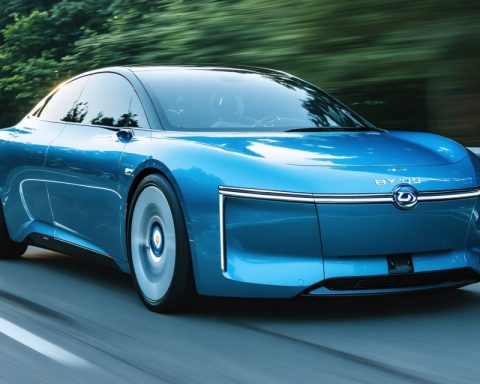- Coca-Cola’s strong fourth-quarter performance has positively impacted its stock market standing, highlighting its financial strength.
- The company effectively manages economic challenges with robust pricing strategies and innovation.
- In response to potential disruptions, Coca-Cola shifts focus to PET bottles, minimizing tariff impacts.
- The brand achieves a 9% growth in pricing and product mix, demonstrating significant pricing power and market adaptability.
- Despite potential strains from increasing interest costs, Coca-Cola remains resilient, sustained by global momentum, particularly in markets like China and the Middle East.
- Coca-Cola’s narrative of innovation and strategic adaptability highlights its dominance in the competitive beverage market.
The fizz in Coca-Cola’s recent fourth-quarter performance is undeniably palpable, sending ripples through the stock market as the brand’s financial prowess sizzles to life once more. Though burdened by looming interest expenses, the soft drink giant deftly maneuvers economic challenges with robust pricing strategies and innovative prowess.
Amidst global tails of tariffs and shifting consumer dynamics, Coca-Cola remains unwavering. With razor-sharp focus, the company pivots away from potential disruptions in aluminum supplies towards versatile PET bottles, absorbing shocks from tariff impositions with ease. Despite investor jitters around SNAP benefits, Coca-Cola’s strategic reach beyond mere retail shelves alleviates these concerns.
Commanding an impressive 9% growth in pricing and product mix, Coca-Cola showcases formidable pricing power. Its diverse portfolio dances gracefully between affordability and premium offerings, capturing the essence of taste across demographics. The brand’s ability to adapt, introducing an array of products at accessible price points, serves as a testament to its entrenched market strategy.
However, storm clouds gather as increasing interest costs—a side effect of financial maneuvers related to tax litigations—cast shadows on the horizon. Analysts caution that higher expenses might strain future profitability. Yet, Coca-Cola stands resilient, buoyed by strong global momentum and promising consumer sentiment, especially in burgeoning markets like China and the Middle East.
In a market crowded with competitors, Coca-Cola’s story underscores a powerful narrative: Determined innovation and strategic adaptability remain its secret elixir. As FY25 unfolds, investors watch closely, drawn to the brand’s symphony of fiscal acumen and consumer-centric evolution. Amidst uncertainty, the iconic beverage titan confidently steers its course, highlighting that in the world of commerce and taste, few can match its unyielding sparkle.
Is Coca-Cola’s Sparkle Enough to Fight Rising Costs and Global Challenges?
Coca-Cola’s Strategic Maneuvers in a Shifting Market
Coca-Cola continues to impress the market with its remarkable fourth-quarter performance, overcoming challenges such as rising interest expenses with innovative strategies and pricing prowess. Despite global economic hurdles like tariffs and changing consumer preferences, Coca-Cola persists as a quintessential leader in the beverage industry.
Key Strategies and Market Trends
– Aluminum Tariffs and Supply Chain Adjustments: Amidst aluminum supply concerns and tariff impacts, Coca-Cola shifts towards using versatile PET bottles. This strategic pivot allows Coca-Cola to maintain productivity without sacrificing cost or quality, showcasing the company’s adaptability in the face of supply chain challenges.
– Pricing and Product Mix: Coca-Cola achieved an impressive 9% growth in pricing and product mix, leveraging its brand’s extensive portfolio to balance affordability and premium offerings. This strategy not only helps attract a wide range of demographics but also ensures the brand remains competitive.
Challenges and Financial Maneuvers
– Interest Expenses and Tax Litigations: Rising interest costs associated with financial moves related to tax litigations are a concern. Analysts warn that such expenses may affect profitability moving forward, posing a challenge that Coca-Cola must navigate strategically.
– Expansion into Emerging Markets: Coca-Cola’s growth momentum is particularly strong in emerging markets such as China and the Middle East. These regions present opportunities for the brand to tap into new consumer bases, enhancing its global presence.
Related Revelations
While Coca-Cola’s recent growth and resilience are notable, other factors could further influence its trajectory:
– Sustainability Initiatives: Coca-Cola continues to invest in sustainability projects, including efforts to recycle and reduce plastic waste. This focus can bolster its brand reputation and align with increasing consumer demand for environmentally friendly products.
– Health and Wellness Trends: As global consumers become more health-conscious, Coca-Cola’s investment in alternative beverages, like low-sugar and functional drinks, positions it well within evolving market dynamics.
Questions and Global Impact
1. How will Coca-Cola balance rising financial liabilities with its ambitious growth strategy?
– The brand will need to carefully manage its interest expenses while seeking growth in emerging markets to maintain financial stability.
2. What role do sustainability and health trends play in Coca-Cola’s long-term planning?
– Embracing sustainability and health trends could significantly enhance Coca-Cola’s brand identity and resonate with future generations, ensuring its continued relevance.
3. How does Coca-Cola’s strategy influence its competitors and the broader beverage industry?
– Coca-Cola’s strategic adaptability and pricing strength set a benchmark for industry standards, compelling competitors to innovate and reshape their market strategies.
Explore More
– To explore Coca-Cola’s ongoing strategies, visit the Coca-Cola Company’s official website.
– For latest insights and trends in the beverage industry, check out Beverage Daily.
As Coca-Cola navigates the complexities of global commerce, its blend of strategic innovation and resilience may well be its strongest asset amidst rising financial pressures and changing consumption patterns.



















